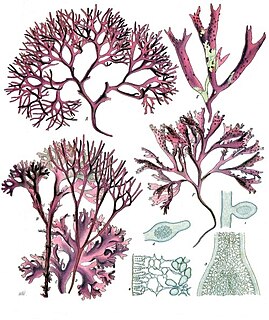Related Research Articles

Porphyra is a genus of coldwater seaweeds that grow in cold, shallow seawater. More specifically, it belongs to red algae phylum of laver species, comprising approximately 70 species. It grows in the intertidal zone, typically between the upper intertidal zone and the splash zone in cold waters of temperate oceans. In East Asia, it is used to produce the sea vegetable products nori and gim. There are considered to be 60 to 70 species of Porphyra worldwide and seven around Britain and Ireland where it has been traditionally used to produce edible sea vegetables on the Irish Sea coast.

Red algae, or Rhodophyta, are one of the oldest groups of eukaryotic algae. The Rhodophyta also comprises one of the largest phyla of algae, containing over 7,000 currently recognized species with taxonomic revisions ongoing. The majority of species (6,793) are found in the Florideophyceae (class), and mostly consist of multicellular, marine algae, including many notable seaweeds. Red algae are abundant in marine habitats but are relatively rare in freshwaters. Approximately 5% of the red algae occur in freshwater environments with greater concentrations found in warmer areas. Except for two coastal cave dwelling species in the asexual class Cyanidiophyceae, there are no terrestrial species, which may be due to an evolutionary bottleneck where the last common ancestor lost about 25% of its core genes and much of its evolutionary plasticity.

Pyropia tenera, also known as gim or nori, is a red algal species in the genus Pyropia. The specific name, tenera, means "delicate" and alludes to its small size. It typically grows to lengths between 20 and 50 cm. It is most typically found in the western Pacific Ocean and the Indian Ocean.
Maritalea is a genus of Gram-negative, strictly aerobic, oxidase- and catalase-positive, rod-shaped, motile bacteria with peritrichous flagella from the family of Hyphomicrobiaceae.
Maritalea mobilis is a Gram-negative, non-spore-forming bacterium from the genus of Maritalea with a single polar flagellum, which was isolated from coastal seawater in Tianjin in China. Zhangella mobilis was transferred to Maritalea mobilis
Maritalea myrionectae is a Gram-negative, rod-shaped, strictly aerobic bacterium from the genus of Maritalea which was isolated from the protist Mesodinium rubrum in Kunsan in the Republic of Korea.
Marinobacter mobilis is a Gram-negative, halophilic, aerobic and motile bacterium from the genus of Marinobacter which has been isolated from sediments from the East China Sea.
Aquimarina agarilytica is a Gram-negative, aerobic, and rod-shaped bacterium from the genus of Aquimarina which has been isolated from the alga Porphyra haitanensis near the Nan'ao County from the China sea near China.

Pyropia is a genus of red algae [seaweed] in the family Bangiaceae. It is found around the world in intertidal zones and shallow water. The genus has folding frond-like blades which are either red, brown or green. Some Pyropia species are used to create nori, and are thus important subjects for aquaculture.
Phaeodactylibacter xiamenensis is a Gram-negative, aerobic, rod-shaped, chemoheterotrophic and non-motile bacterium from the genus of Rubidimonas which has been isolated from the alga Phaeodactylum tricornutum from Xiamen in China.
Catenovulum is a bacteria genus from the family of Alteromonadaceae.
Catenovulum maritimum is a Gram-negative, heterotrophic and facultatively anaerobic bacterium from the genus of Catenovulum which has been isolated from surface of the alga Porphyra yezoensis from Weihai in China.
Pythium porphyrae, is a parasitic species of oomycete in the family Pythiaceae. It is the cause of red rot disease or red wasting disease, also called akagusare (赤ぐされ) in Japanese. The specific epithet porphyrae (πορφυρα) stems from the genus of one of its common hosts, Porphyra, and the purple-red color of the lesions on the thallus of the host. However, many of its hosts have been moved from the genus Porphyra to Pyropia.
Amylibacter is a genus of bacteria from the family of Rhodobacteraceae.
Tenacibaculum agarivorans is a Gram-negative, aerobic, rod-shaped agar-digesting bacterium from the genus of Tenacibaculum which has been isolated from the alga from the coast of Weihai in China.
Bacteroides plebeius is a microbe found in the human gut, most often found in Japan natives. The microbe is believed to have obtained the gene for degradation of porphyran via horizontal gene transfer. The porphyranase encoding gene is believed to have been derived from the microbe Zobellia galactanivorans. Microbes in the gut are responsible for their production of carbohydrate active enzymes or CAZymes. CAZymes are responsible for a variety of functions involving complex carbohydrates such as synthesis, recognition, or metabolism. Moreover, CAZymes are not encoded in the human genome, highlighting the importance of microbes in digestive processes. B. plebeius contains a gene known as BACPLE_01693 which encodes β-porphyranase-A.
Thioflavicoccus is a Gram-negative, obligately phototrophic, strictly anaerobic and motile genus of bacteria from the family of Chromatiaceae with one known species.
Algimonas ampicilliniresistens is a Gram-negative, prosthecate and motile bacterium from the genus of Algimonas which has been isolated from the alga Porphyra yezoensis.
Algimonas porphyrae is a Gram-negative bacterium from the genus of Algimonas which has been isolated from the alga Porphyra yezoensis.
References
- 1 2 UniProt
- ↑ Straininfo of Maritalea porphyrae
- ↑ Fukui, Y; Abe, M; Kobayashi, M; Ishihara, K; Oikawa, H; Yano, Y; Satomi, M (2012). "Maritalea porphyrae sp. nov., isolated from a red alga (Porphyra yezoensis), and transfer of Zhangella mobilis to Maritalea mobilis comb. Nov". International Journal of Systematic and Evolutionary Microbiology. 62 (Pt 1): 43–8. doi: 10.1099/ijs.0.028704-0 . PMID 21317275.